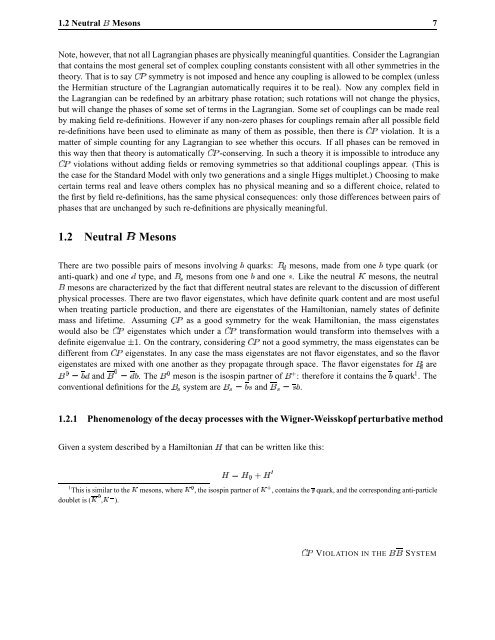Violation in Mixing
Violation in Mixing
Violation in Mixing
You also want an ePaper? Increase the reach of your titles
YUMPU automatically turns print PDFs into web optimized ePapers that Google loves.
1.2 Neutral � Mesons 7<br />
Note, however, that not all Lagrangian phases are physically mean<strong>in</strong>gful quantities. Consider the Lagrangian<br />
that conta<strong>in</strong>s the most general set of complex coupl<strong>in</strong>g constants consistent with all other symmetries <strong>in</strong> the<br />
theory. That is to say �È symmetry is not imposed and hence any coupl<strong>in</strong>g is allowed to be complex (unless<br />
the Hermitian structure of the Lagrangian automatically requires it to be real). Now any complex field <strong>in</strong><br />
the Lagrangian can be redef<strong>in</strong>ed by an arbitrary phase rotation; such rotations will not change the physics,<br />
but will change the phases of some set of terms <strong>in</strong> the Lagrangian. Some set of coupl<strong>in</strong>gs can be made real<br />
by mak<strong>in</strong>g field re-def<strong>in</strong>itions. However if any non-zero phases for coupl<strong>in</strong>gs rema<strong>in</strong> after all possible field<br />
re-def<strong>in</strong>itions have been used to elim<strong>in</strong>ate as many of them as possible, then there is �È violation. It is a<br />
matter of simple count<strong>in</strong>g for any Lagrangian to see whether this occurs. If all phases can be removed <strong>in</strong><br />
this way then that theory is automatically �È -conserv<strong>in</strong>g. In such a theory it is impossible to <strong>in</strong>troduce any<br />
�È violations without add<strong>in</strong>g fields or remov<strong>in</strong>g symmetries so that additional coupl<strong>in</strong>gs appear. (This is<br />
the case for the Standard Model with only two generations and a s<strong>in</strong>gle Higgs multiplet.) Choos<strong>in</strong>g to make<br />
certa<strong>in</strong> terms real and leave others complex has no physical mean<strong>in</strong>g and so a different choice, related to<br />
the first by field re-def<strong>in</strong>itions, has the same physical consequences: only those differences between pairs of<br />
phases that are unchanged by such re-def<strong>in</strong>itions are physically mean<strong>in</strong>gful.<br />
1.2 Neutral � Mesons<br />
There are two possible pairs of mesons <strong>in</strong>volv<strong>in</strong>g � quarks: �� mesons, made from one � type quark (or<br />
anti-quark) and one � type, and �× mesons from one � and one ×. Like the neutral à mesons, the neutral<br />
� mesons are characterized by the fact that different neutral states are relevant to the discussion of different<br />
physical processes. There are two flavor eigenstates, which have def<strong>in</strong>ite quark content and are most useful<br />
when treat<strong>in</strong>g particle production, and there are eigenstates of the Hamiltonian, namely states of def<strong>in</strong>ite<br />
mass and lifetime. Assum<strong>in</strong>g �È as a good symmetry for the weak Hamiltonian, the mass eigenstates<br />
would also be �È eigenstates which under a �È transformation would transform <strong>in</strong>to themselves with a<br />
def<strong>in</strong>ite eigenvalue ¦ . On the contrary, consider<strong>in</strong>g �È not a good symmetry, the mass eigenstates can be<br />
different from �È eigenstates. In any case the mass eigenstates are not flavor eigenstates, and so the flavor<br />
eigenstates are mixed with one another as they propagate through space. The flavor eigenstates for �� are<br />
� � �� and � � ��. The � meson is the isosp<strong>in</strong> partner of � : therefore it conta<strong>in</strong>s the � quark 1 . The<br />
conventional def<strong>in</strong>itions for the �× system are �× � �× and �× � ×�.<br />
1.2.1 Phenomenology of the decay processes with the Wigner-Weisskopf perturbative method<br />
Given a system described by a Hamiltonian À that can be written like this:<br />
À � À À<br />
1 This is similar to the à mesons, where à , the isosp<strong>in</strong> partner of à , conta<strong>in</strong>s the × quark, and the correspond<strong>in</strong>g anti-particle<br />
doublet is (Ã ,Ã ).<br />
�È VIOLATION IN THE �� SYSTEM















